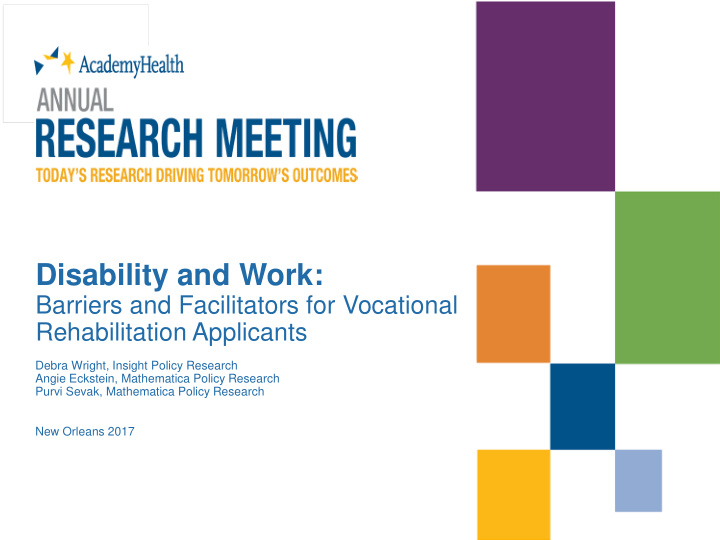



Disability and Work: Barriers and Facilitators for Vocational Rehabilitation Applicants Debra Wright, Insight Policy Research Angie Eckstein, Mathematica Policy Research Purvi Sevak, Mathematica Policy Research New Orleans 2017
Support and Acknowledgments Project conducted at Mathematica Policy Research and Kessler Foundation Funded by National Institute on Disability, Independent Living, and Rehabilitation Research (NIDILRR), U.S. Department of Health and Human Services (HHS), Rehabilitation Research and Training Center on Individual Characteristics, under cooperative agreement 90RT5017- 01-01 Findings and conclusions are those of the authors and do not represent the policy of HHS or NIDILRR; authors retain sole responsibility for any errors or omissions 2
Purpose of Presentation Describe Survey of Disability and Employment (SDE) and data Provide general descriptive statistics based on survey results and implications Discuss other/current work and use of data for future research 3
Background and Motivation 4
Disability and Employment Compared to working- age people without disabilities, those with disabilities have persistently lower levels of employment and earnings $10,000 People with disabilities lo we r fo r are nearly twice as likely fo r pe o ple with disa b ilitie s to live in poverty as their tha n witho ut nondisabled peers 5
Disability and Employment Research using administrative and survey data reveals large differences in employment by— Type of disability Race Education State of residence Little information available on what factors are associated with better outcomes and why some groups of individuals fare better than others 6
Research Objectives Provide new insights into barriers and facilitators to employment among individuals with disabilities and explain subgroup differences Examine individual and environmental factors that contribute to successful outcomes 7
Summary of Key Findings Most have worked or are working and have high perception of ability to succeed in work A majority report it is very important they work Health problems restrict work, but there are many nonhealth barriers Difficulty finding a job Lack of skills Lack of accessibility Workplace accommodations increase success 8
Study Design 9
Questionnaire Content ICF Disability and Health Mod el 10 10
Population Target population: working-age individuals with disabilities who had recently applied for state or federal vocational rehabilitation (VR) services through a state VR agency Avoids prescreening for disability VR applicants are employment focused Likely to have more recent employment experiences 11 11
Sample and Survey Methods Worked with three state VR agencies (NJ, MS, and OH) to identify and sample individuals on rolling basis Sampled 5,153 applicants; 2,804 gave consent and participated in the survey (57-percent response rate) All interviews were completed by telephone Assist ive technologies and proxies used (4 percent completed by proxy) 12 12
Personal Percentage Percentage SDE Characteristics VR admin Sex Male 49.8 54.5 Female 50.2 45.5 Race White only 57.4 68.7 Black only 33.3 27.0 Other 9.3 4.2 Age 25−30 16.9 16.9 31−50 54.9 54.9 51−60 28.3 28.3 Educational Attainment < High school 15.5 17.4 High school 41.4 43.1 > High school 43.2 39.6 13 13
Respondents Report Physical and Psychiatric Conditions and Limitations Most Commonly Reported Impairments 14 14
Key Findings Employment 15 15
Employment History Years Since Worked 16 16
Importance of Work by Employment History (Extremely or Very Important) 17 17
Self-Perceived Executive Functioning Is High Perseveres until task done 78% Easily distracted Reliable worker 20% 86% 18 18
Key Findings Environmental Factors/Barriers and Facilitators 19 19
Barriers to Work: Top Five Reasons Left Last Job 20 20
Barriers to Work: Why Not Working Disability Related 21 21
Barriers to Work: Why Not Working Nondisability Related 22 22
Reasons Health Prevents Work 23 23
Facilitators to Work: Accommodations Received 24 24
Summary and Conclusions 25 25
PWD Want To Work and Can Work With Accommodations Most VR applicants want to work and place importance on employment There are many barriers to employment, but accommodations have the potential to improve employment outcomes 26 26
Implications for Policy/Practice Understanding underlying barriers that impact employment outcomes can help us tailor services and resources to support people with disabilities Improved employment outcomes could result in reduced poverty rates and reliance on social programs for people with disabilities 27 27
Current Research on the SDE Title Author Outlet Personal characteristics of vocational Journal of Vocational Eckstein, A., Sevak, P., & rehabilitation applicants: Findings from the Rehabilitation, 46, Wright, D. Survey of Disability and Employment 2017 The role of workplace accommodations in Sevak, P., & Anand, P. Under review the employment of people with disabilities Psychiatric Psychiatric versus physical disabilities: A Rehabilitation Journal, comparison of barriers and facilitators to Sevak, P., & Khan, P. 40(2), 2017 employment Journal of Vocational Variations in social capital among Brucker, D., Botticello, Rehabilitation, 46, vocational rehabilitation applicants A., O’Neill, J., & Kutlik, A. 2017 Surveying vocational rehabilitation Chandler, J. Under review applicants online: A feasibility study 28 28
Future Research Exploring VR and employment outcomes of SDE responden ts Working with two states to obtain data from agency’s case management system and state wage data (from UI program) Examine relationships between barriers and facilitators reported in SDE and outcomes 29 29
Data Access Survey dataset can be accessed and used by other researchers with permission Contact Angie Eckstein aeckstein@mathematica- mpr.com John O’Neill JONeill@kesslerfoundation.org 30 30
Contact Information Debra Wright dwright@insightpolicyresearch.com Angie Eckstein aeckstein@mathematica-mpr.com 31 31
Recommend
More recommend